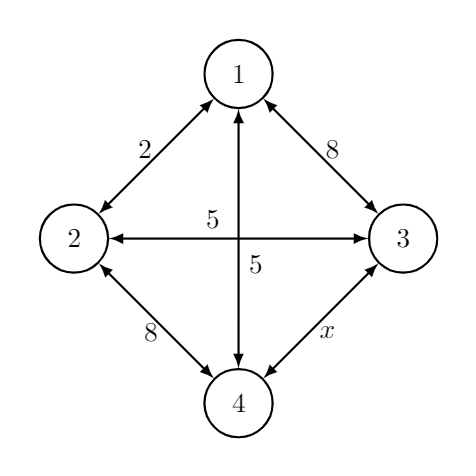
Let us list down the shortest edge between each pair of vertices $x,y$ in the graph
$$\begin{array}{|c|c|c|}\hline \textbf{x} & \textbf{y} & \textbf{shortest path from x to y} \\\hline \text{1} & \text{2} & \text{2} \\\hline \text{1} & \text{3} & \text{there is a direct path from 1 to 3 of weight 8.We can also choose to go}\\ && \text{ via node 4 with total path weight $5+x.$ if $5+x<8(x<3)$ then shortest}\\&&\text{path is $5+x$ otherwise shortest path is the weight of the direct path}\\ && \text{which is 8} \\\hline \text{1} & \text{4} & \text{5} \\\hline \text{2} & \text{3} & \text{5} \\\hline \text{2} & \text{4} & \text{there is a direct path from 2 to 4 of weight 8. We can also choose to go}\\ && \text{via node 3 with total path weight}{ 5+x}\text{. If }{ 5+x<8(x<3)}\text{ the shortest}\\ && \text{path is 5+x. otherwise shortest path is the weight of the direct path}\\ && \text{which is 8} \\\hline \text{3} & \text{4} & \text{We can chose to go through the direct path of weight x or via nodes 2, 1 }\\ && \text{to node 4 with weight } 5+2+5=12 \text{. If }{x<12}\text{ then we will chose x to be the shortest}\\&& \text{path otherwise $12$ is the shortest path} \ \\\hline \end{array}$$
- Case 1: Let us say $x < 3$. Say $x = 2$.
When we put $x = 2$ the above table is modified as
$$\begin{array}{|c|c|c|}\hline \textbf{x} & \textbf{y} & \textbf{shortest path from x to y} \\\hline \text{1} & \text{2} & \text{2} \\\hline \text{1} & \text{3} & \text{7} \\\hline \text{1} & \text{4} & \text{5} \\\hline \text{2} & \text{3} & \text{5} \\\hline \text{2} & \text{4} & \text{7} \\\hline \text{3} & \text{4} & \text{2 // Note that the shortest path between nodes $3$ and $4$ is $x =2$} \\\hline \end{array}$$
- Case 2: $3 \leq x < 13$. Let's say $x = 12$. The table is now modified as
$$\begin{array}{|c|c|c|}\hline \textbf{x} & \textbf{y} & \textbf{shortest path from x to y} \\\hline \text{1} & \text{2} & \text{2} \\\hline \text{1} & \text{3} & \text{8} \\\hline \text{1} & \text{4} & \text{5} \\\hline \text{2} & \text{3} & \text{5} \\\hline \text{2} & \text{4} & \text{8} \\\hline \text{3} & \text{4} & \text{12 // Note that the shortest path between nodes $3$ and $4$ is $x=12$} \\ && \text{and one of the shortest path is the direct edge $x$} \\ \hline \end{array}$$
Now the question asks you to find the largest possible integer value of $x$ such that shortest path between at least one pair of nodes in the graph is equal to $x.$ For values $x = 2,3,4,\ldots,12$ the shortest path between node $3$ and $4$ is equal to $x$.
The largest among this is $x = 12$. So the answer is $12$
PS: If the question is modified as "The largest possible integer value of $x$, for which the shortest path between some pair of vertices is guaranteed to contain the edge with weight $x$ is"
then the answer will be $11.$
Correct Answer: $12.$